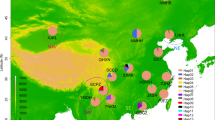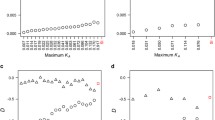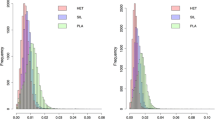Abstract
An electrophoretic study was carried out to compare the geographic pattern of genetic variation in Drosophila simulans with that of its sibling species, Drosophila melanogaster. An identical set of 32 gene-protein loci was studied in four geographically distant populations of D. simulans and two populations of D. melanogaster, all originating from Europe and Africa. The comparison yielded the following results: (1) tropical populations of D. simulans were, in terms of the number of unique alleles, average heterozygosity per locus, and percentage of loci polymorphic, more variable than conspecific-temperate populations; (2) some loci in both species showed interpopulation differences in allele frequencies that suggest latitudinal clines; and (3) temperate-tropical genetic differentiation between populations was much less in D. simulans than in D. melanogaster. Similar differences between these two species have previously been shown for chromosomal, quantitative, physiological, and middle-repetitive DNA variation. Estimates of N m (number of migrants per generation) from the spatial distribution of rare alleles suggest that both species have similar levels of interpopulation gene flow. These observations lead us to propose two competing hypotheses: the low level of geographic differentiation in D. simulans is due to its evolutionarily recent worldwide colonization and, alternatively, D. simulans has a narrower niche than D. melanogaster. Geographic variation data on different genetic elements (e.g., mitochondrial DNA, two-dimensional proteins, etc.) are required before these hypotheses can be adequately tested.
Similar content being viewed by others
References
Anderson, P. R., and Oakeshott, J. G. (1984). Parallel geographical patterns of allozyme variation in two sibling Drosophila species. Nature 308729.
Ashburner, M., and Lemeunier, F. (1976). Relationship within the melanogaster species subgroup of the genus Drosophila (sophophora). I. Inversion polymorphisms in Drosophila melanogaster and Drosophila simulans. Proc. R. Soc. Lond. B. 193137.
Baba Aissa, F., and Solignac, M. (1984). La plupart des populations de Drosophila simulans ont probablement pour ancetre une femelle unique dans un passe recent. C.R. Acad. Sci. Paris 299289.
Baker, H. G. (1965). Characteristics and modes of origin of weeds. In Baker, H. G., and Stebbins, G. L. (eds.), The Genetics of Colonizing Species Academic Press, New York, pp. 147–172.
Berger, E. M. (1970). A comparison of gene-enzyme variation between Drosophila melanogaster and D. simulans. Genetics 66677.
Bregliano, J. C., and Kidwell, M. (1983). Hybrid dysgenesis determinants. In Shapiro, J. A. (ed.), Mobile Genetic Elements Academic Press, New York, p. 396.
Brookfield, J. F. Y., Montgomery, E., and Langley, C. H. (1984). Apparent absence of transposable element related to the P elements of D. melanogaster in other species of Drosophila. Nature 310330.
Cabrera, V. M., Gonalez, A. M., Larruga, J. H., and Gullón, A. (1982). Electrophoretic variability in natural populations of Drosophila melanogaster and Drosophila simulans. Genetica 59191.
Choudhary, M., and Singh, R. S. (1987). Historical effective size and the level of genetic diversity in Drosophila melanogaster and Drosophila pseudoobscura. Biochem. Genet. 2541.
David, J. R., and Boequet, C. (1975). Similarities and differences in latitudinal adaptation of two Drosophila sibling species. Nature 257588.
David, J. R., and Tsacas, J. (1981). Cosmopolitan, subcosmopolitan and widespread species: Different strategies within the Drosophila family. C.R. Soc. Biogeog. 5711.
David, J. R., Louis, J., McKenzie, J. A., Rocha-pite, M., and Vouidibio, J. (1984). Comparative demography of the cosmopolitan sibling species, Drosophila melanogaster and D. simulans, under temperate and tropical climate. Ann. Soc. Entomol. Fr. 20(2):135.
Dowsett, A. P., and Young, M. W. (1982). Differing levels of dispersed repetitive DNA among closely related species of Drosophila. Proc. Natl. Acad. Sci. USA 794570.
Eisses, K. T., van Dijk, H., and van Delden, W. (1979). Genetic differentiation within the melanogaster species group of the genus Drosophila (sophophora). Evolution 331063.
Green, M. M. (1976). Mutable and mutator loci. In Ashburner, M., and Novistsky, E. (eds.), The Genetics and Biology of Drosophila, Vol. 1(b) Academic Press, New York, pp. 929–944.
Gonzalez, A. M., Cabrera, V. M., Larruga, J. M., and Gullón, A. (1982). Genetic distance in the sibling species Drosophila melanogaster, Drosophila simulans, and Drosophila mauritiana. Evolution 36(3):517.
Hale, L. R., and Singh, R. S. (1985). Mitochondrial DNA variation in natural populations of Drosophila melanogaster and D. simulans. Genetics 110:s42.
Harris, H., and Hopkinson, D. A. (1976). Handbook of Enzyme Electrophoresis in Human Genetics North-Holland, Amsterdam.
Hyytia, P., David, J. R., Capy, P., and Singh, R. S. (1985). Enzymatic and quantitative variation in European and African populations of Drosophila simulans. Heredity 54209.
Kojima, K., Gillespie, J., and Tobari, Y. N. (1970). A profile of Drosophila enzymes assayed by electrophoresis. I. Number of alleles, heterozygosities and linkage disequilibrium in glucose metabolizing systems and some other enzymes. Biochem. Genet. 4627.
Lemeunier, F., David, J. R., Tsacas, L., and Ashburner, M. (1985). The Drosophila melanogaster species group. In Ashburner, M., Carson, H. L., and Thompson, J. N., Jr. (eds.), The Genetics and Biology of Drosophila, Vol. 3(e) Academic Press, New York.
Levitan, M., and Williamson, D. L. (1965). Evidence for the cytoplasmic and possibly episomal nature of a chromosome breaker. Genetics 52456.
Nei, M. (1975). Molecular Population Genetics and Evolution American Elsevier, New York.
Nei, M., Muruyama, T., and Chakraborty, R. (1975). The bottleneck effect and genetic variability in populations. Evolution 291.
O'Brien, S. J., and McIntyre, R. J. (1969). An analysis of gene-enzyme variability in natural populations of Drosophila melanogaster and D. simulans. Am. Nat. 10397.
Onishi, S., Leigh Brown, A. J., Voelker, R. A., and Langley, C. H. (1982). Estimation of genetic variability in natural populations of Drosophila simulans by two-dimensional and starch gel electrophoresis. Genetics 100127.
Parsons, P. A. (1973). Genetics of resistance to environmental stresses in Drosophila populations. Annu. Rev. Genet. 7239.
Parsons, P. A. (1975). The comparative evolutionary biology of the sibling species, Drosophila melanogaster and D. simulans. Q. Rev. Biol. 50151.
Parsons, P. A. (1977). Resistance to cold temperature stress in populations of Drosophila melanogaster and D. simulans. Aust. J. Zool. 25693.
Parsons, P. A. (1979). Resistance of the sibling species Drosophila melanogaster and D. simulans to high temperatures in relation to humidity: Evolutionary implications. Evolution 33131.
Parsons, P. A. (1980). Adaptive strategies in natural populations of Drosophila. Theory. Appl. Genet. 57257.
Parsons, P. A., and Stanley, S. M. (1980). Domesticated and widespread species. In Ashburner, M., Carson, H. L., and Thompson, J. N. (eds.), The Genetics and Biology of Drosophila, Vol. 3(a), Academic Press, New York, pp. 349–393.
Parsons, P. A. (1983). The Evolutionary Biology of Colonizing Species Cambridge University Press, Cambridge.
Patterson, J. T., and Stone, W. S. (1952). Evolution in the Genus Drosophila, Macmillan, New York.
Singh, R. S., and Rhomberg, L. R. (1987a). A comprehensive study of genic variation in natural populations of Drosophila melanogaster. I. Estimates of gene flow from rare alleles. Genetics (in press).
Singh, R. S., and Rhomberg, L. R. (1987b). A comprehensive study of genic variation in natural populations of Drosophila melanogaster. II. Estimates of heterozygosity and causes of geographic differentiation. Genetics (in press).
Singh, R. S., Hickey, D. A., and David, J. R. (1982). Genetic differentiation between geographically distant populations of Drosophila melanogaster. Genetics 101235.
Slatkin, M. (1985). Rare alleles as indicators of gene flow. Evolution 39(1):53.
Steiner, W. W. M. (1977). Niche width and genetic variation in Hawaiian Drosophila. Am. Nat. 1111037.
Steiner, W. W. M. (1980). On niche width and genetic variation, parametrical problems, and gene pool differentiation in Drosophila. Am. Nat. 115596.
Steiner, W. W. M., Sung, K. C., and Paik, Y. K. (1976). Electrophoretic variability in island populations of Drosophila simulans and Drosophila immigrans. Biochem. Genet. 14495.
Triantaphyllidis, C. D., Panourgias, J. N., Scouras, Z. G., and Ioannidis, G. C. (1980). Comparison of gene-enzyme variation between Drosophila melanogaster and D. simulans. Genetica 51227.
Triantaphyllidis, C. D., Scouras, Z. G., Panourgias, J. N., and Ioannidis, G. C. (1982). Allozyme variation in Greek wild populations of Drosophila melanogaster and D. simulans along a north-south gradient. Genetica 58129.
Van Valen, L. (1965). Morphological variation and the width of the ecological niche. Am. Nat. 99377.
Voelker, R. A. (1974). the genetics and cytology of a mutator factor in Drosophila melanogaster. Mutat. Res. 22265.
Woodruff, R. C., and Ashburner, M. (1978). The frequency of X-ray induced chromosome breakage in the sibling species Drosophila melanogaster and D. simulans Am. Nat. 12456.
Yamaguchi, O., and Mukai, T. (1974). Variation of spontaneous occurrence rates of chromosomal aberrations in the second chromosome of Drosophila melanogaster. Genetics 781209.
Yamaguchi, O., Cardellino, R. A., and Mukai, T. (1976). High rates of occurrence of spontaneous chromosome aberrations in D. melanogaster. Genetics 83409.
Author information
Authors and Affiliations
Additional information
We thank the Natural Science and Engineering Research Council of Canada for financial support (Grant A0235 to R.S.S.).
Rights and permissions
About this article
Cite this article
Singh, R.S., Choudhary, M. & David, J.R. Contrasting patterns of geographic variation in the cosmopolitan sibling species Drosophila melanogaster and Drosophila simulans . Biochem Genet 25, 27–40 (1987). https://doi.org/10.1007/BF00498949
Received:
Revised:
Issue Date:
DOI: https://doi.org/10.1007/BF00498949




